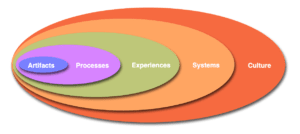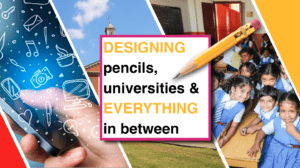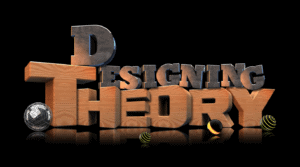Research: Education by Design
The idea of design

Design is core to my identity, to who I am. Education is the space within which I function but I try to approach everything I do as a designer.
Herb Simon, in his book, The Sciences of the Artificial, famously wrote:
Everyone designs who devises courses of action aimed at changing existing situations into preferred ones.
In one fell swoop, Simon situated design as playing a role across a range of human-centered professions, whether it be graphic design, architecture, medicine, or social policy.
And most relevant to us: Education.
Which is why I prefer to call myself an educational designer (rather than educational researcher). I see the world through the lens of design. Everything in the world around me, education, parenting, research, to me are enriched by taking on this perspective: a design lens as it were.
It is no surprise, thus, that one of my favorite courses I teach is called Education by Design. The course intro is as follows:
DCI 691 (Education by Design) is a course about design. Design as a way of thinking and as a process that values collaboration, context, and diverse perspectives. Design as an approach that generates creative solutions to complex (wicked) problems of practice, particularly in education.
Design is both a noun and a verb, a product and a process. Design is central to the construction of any process or artifact—be it a website or a car; an ATM machine or educational policy. Design touches on many different disciplines—science, technology, engineering, education, psychology, sociology, organizational behavior, and art, to name a few. A multi-dimensional issue like design, particularly in education, requires a multifaceted approach.
for The 5 spaces for design in education

Everything in education is designed (one can argue whether this is intentional or not or whether the outcomes are the ones we want/like) but the broader point is that there is nothing “natural” about the systems of education we have around us. They are constructed by us, by humans. Whether the idea of the curriculum or seat-time, learning metrics or the idea of problem-based learning, or the idea of school, these are all human creations, structures adapted for some purpose (to quote Perkins and his definition of design).
That said, there is something fundamentally different about designing a textbook v.s. a chair; or designing a school v.s. designing an instructional plan. The differences have as much to do with the scale and the complexity of the tasks as it has to do with human psychology i.e. people’s desires and needs. That is not all. Everything we do in education works within broader organizational, policy and information structures that constrain and guide what we can do, and the complex feedback loops that can emerge from the inherent complexity (wickedness) of the enterprise. What this means is that designers have to function differently depending on the “space” they are working within.
In our recent work, Melissa Warr and I, have been developing a framework that we are calling the Five Spaces for Design in Education. In brief, we argue that it may be productive to think of five spaces for the design in education: artifacts, processes, experiences, systems and culture. Moreover, working within these spaces requires different tools, elements, practices, knowledge and judgement that we as designers need to bring to the task.
The best introduction to the FIve Spaces Framework is a series of videos made for ASU’s Learning Sparks series. You can find all the videos here: 6 videos (on the 5 spaces for design in education
In addition Melissa Warr maintains a page on the talkingaboutdesign.com website that lists all the publications/presentations that have emerged from this line of work.
My journey through design

I was invited to give a keynote at the 50th Anniversary of the Industrial Design Center. It was here at IDC that I was introduced to the idea of design—something that I did not know much about before, but something I seemed to fit right into. I took this as an opportunity to look back over my journey through design and education. You can read more about it – and watch the video here.
Designing Theory

Theories play a critical role in the development of a discipline. Theories allow us to understand, explain and predict phenomena in the world. That said it is often difficult to say just where theories come from. The standard model—that data lead to laws, that in turn lead to theories—has been undermined by philosophers of science for a while now. They argue, and I would suggest rightly, that theories are often under-determined by data, i.e. there is never enough data that will, inevitably, lead us to a particular theory. This situation is particularly problematic given the important role theories play in scholarly lives.
In Warr, Scragg & Mishra (2020) we argue that it may be productive to see the development of theory as being akin to a process of design —that of creating an artifact (albeit a conceptual one) that has “a structure adapted to a purpose” and demonstrates “goodness of fit. We argue that, viewing theory development as an act of design might lead to a stronger theoretical and practical scholarship and can help us address some key challenges in the field.
Teachers as Designers

What does it mean for a teacher to be described as a designer, or for the act of teaching to be considered an act of design?
The paper cited below is a synthesis of 10 years of educational research into the idea that it is productive to see educators as designers—as designers of curriculum, designers of learning experiences. We analyzed citation patterns of key journal articles to (a) identify emergent clusters or strands of work; and (b) the manner in which the roles teachers play as designers varies across time.
Warr, M., Mishra, P. (2021). Integrating the discourse on teachers and design: An analysis of 10 years of scholarship. Teaching and Teacher Education. https://doi.org/10.1016/j.tate.2020.103274
Abstract: This article presents a content and network analysis of a decade (2007 – 2017) of highly-cited literature on teachers and design. Constructs and definitions were compared in an interpretive content analysis, resulting in 10 strands, each a cluster of literature that frames teaching and design in a particular way. A citation network analysis provided insight into how the strands are conceptually related. Further analysis highlighted how each strand described what, when, and how teachers design, and the value of considering teachers as designers. The results suggest that teaching not only includes design activities, but could be considered a design profession. This perspective has implications for teacher education, specifically the development of professional knowledge.
More here.
Blog posts related to Design
Teachers ARE designers (in many different ways)
One of the pleasures of academia is working with awesome graduate students. This paper is an example of such a collaboration. Melissa Warr, for some reason or the other, decided to do a network analysis of some of the top-cited papers related to teaching and design....
Creativity, risk-taking, education
EduSummIT is a global community of policy-makers, researchers, and educators working together to move education into the digital age. The last EduSummit (2019) was held in Quebec, Canada and I was a member of Thematic Working Group 3 (TWG3) on Creativity for Teachers...
Goodbye 2020 (whew), welcome 2021
2020 has been a heck of a year... and maybe in hindsight (hindsight, of course, being 2020) it will all make sense. But, I think we can all agree that it is time to let it go. A lot has changed this past year but one tradition we wanted to keep alive was the short...
China, Australia, Nepal & Australia: A zoom tour
Over the past couple of months I have been asked to give presentations at a variety of different conferences or organizations spread across the world. They are archived below. I was invited to give a talk as part of the Dean's Lecture Series at the School of...
Embracing failure (in a first year technology course)
In his book The child and the curriculum; and The school and society John Dewey identified four key impulses for learning that he placed at the foundation of the curriculum. The key education challenge, he argued, is to nurture these impulses for lifelong learning:...
Education in a pandemic: A crisis & opportunity
Last year I was in Israel to present at the Meital Conference. When I was there I was interviewed by Lior Detal, the education correspondent for TheMarker - which led to an article in the magazine. Earlier this year, once the COVID crisis was in full swing, I was...
Systems level change in education
How do you design for change in complex systems—like education? Implementing large-scale changes within educational systems can be a challenging task. Doing so requires many actors, working at different organizational levels (and perhaps across organizations), to not...
Designing the futures of STEM education
“What knowledge is of most worth?” is a question asked over a 100 years ago by the English philosopher, Herbert Spencer. His unequivocal answer was—science. This question (and his answer) resonates even today, though the context within which it is asked, and how we...
Teenagers, retirement & the new abnormal
The economist and thinker Andrew Scott once said something that blew me away. He said that: The 20th century created the idea of teenagers and retirement. I had never considered that the idea of teenagers and retirement was a 20th century idea. These seemed to...
Call: Failure and Creative Risk in Technology-Enhanced Learning
I am excited to announce a call for articles on Failure and Creative Risk in Technology-Enhanced Learning for a special section in the journal Tech Trends, edited by Danah Henriksen, Punya Mishra, Edwin Creely, and Michael Henderson. You can download the the...
Of metaphors & molecules: Bridging STEM & the arts
Update on blog post that was published May 30, 2018 - since the article is now published (2 years since it was accepted for publication). Square Root: Illustration by Punya Mishra What do President Kennedy's speeches have to do with cell biology? And what does the...
A systems view of technology infusion
One of the significant changes in my way of thinking about technology integration has been a shift in focus—away from designing training and programs that target individual teachers to designing systems (both at K12 and higher education levels) that support teachers...
Us in Flux: A conversation with Sarah Pinsker
The Center for Science and the Imagination at ASU has a new series called Us in Flux. Every two weeks they publish a (super-short) short story that explores "themes of community, collaboration, and collective imagination in response to transformative events." They...
100,000
https://www.youtube.com/watch?v=Ic8FHlawAdA Over the Memorial day long-weekend I just felt the need to create something to commemorate the 100,000 individuals, in the United States, who have lost their lives over the past few months to COVID19. That is a staggering...
From being to becoming: Keynote by Shawn Loescher
It is rarely that I hear a talk that blows me away. We have all seen the TED talks, and their mutant offspring. The over-hyped music and catchy taglines; the speaker in front of a rapt audience; the crafted delivery with its carefully punctuated pauses and reveals,...
Punya Mishra
Associate Dean of Scholarship & Innovation
Professor, Division of Educational Leadership & Innovation
Mary Lou Fulton Teachers College
Arizona State University
Email: punya[dot]mishra[at]asu.edu
Web: punyamishra.com
LinkedIn: PunyaMishra
Twitter: @punyamishra
©
All the content (text, images, photographs, videos) on this site have been created by me, Punya Mishra, (unless specified otherwise). I would like to thank the artists/photographers/designers who have made their work freely available for re-use on sites such as Wikimedia Commons, Pixabay and Unsplash. Most of the graphics I create build on your generosity, and I am deeply grateful.
This website is designed and maintained by me, Punya Mishra, using WordPress combined the Divi plugin and is hosted on Cloudways.
